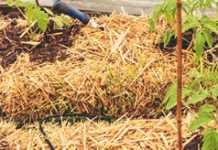Gardeners face annual battle of protecting crops from aggressive insect
If gardeners get this eerie feeling that they’re feeding grasshoppers right now, they’re likely not alone.
Kansas State University horticulture expert Cynthia Domenghini said many grasshopper varieties make their home in gardens this time of year, preferring the luxurious accommodations – rife with leaves, flowers, stems and seeds – as they molt and mature.
Grasshoppers have huge appetites and sharp, chewing mouth parts to damage fruit, defoliate a tree or even devour entire plants. They are considered one of the most destructive garden pests.
“Full-sized adults are the most problematic because they have wings and can cover more ground,” Domenghini said. “They also have tougher skin, making insecticides less effective.”
Gardeners should act early if they detect grasshopper infestations.
“Nets and floating row covers can be effective protection for small areas, though grasshoppers have been known to chew through netting,” Domenghini said. “Gardeners who want to avoid synthetic (insecticide) treatments have to decide the amount of damage to garden plants that they can tolerate. In suburban areas, it is important for gardeners to work together to control grasshoppers and limit the destruction.”
Domenghini said insecticides are usually effective when the spray comes into direct contact with the grasshopper.
“Most insecticides have to be re-applied to eliminate new arrivals,” she said. “Immature grasshoppers are limited in their range since they travel by foot. They are easiest to control at this stage.”
For updated recommendations on pesticides, including a protocol for applying them, gardeners are encouraged to contact their local K-State Research and Extension office.
Domenghini and her colleagues in K-State’s Department of Horticulture and Natural Resources produce a weekly Horticulture Newsletter with tips for maintaining home landscapes and gardens.
Interested persons can subscribe to the newsletter, as well as send their garden and yard-related questions to Domenghini at [email protected], or contact your local K-State Research and Extension office.



